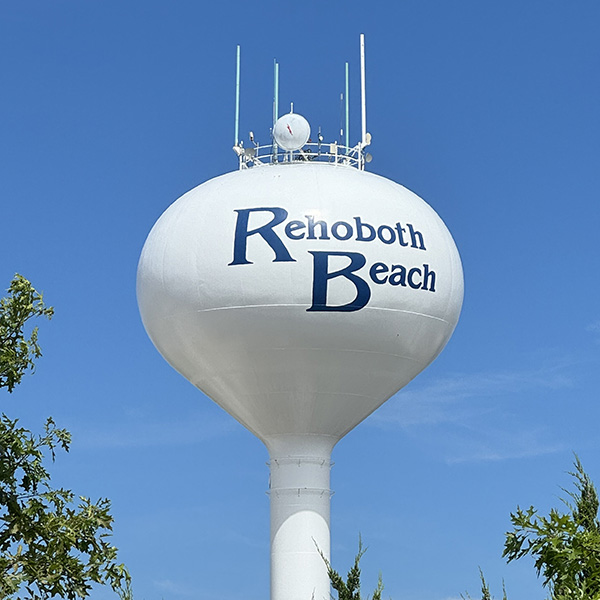The City of Rehoboth Beach provides safe drinking water to 6,000 residential and commercial customers within the city limits and beyond. The city’s water department maintains infrastructure to ensure delivery of safe, clean water to customers. To further enhance water quality and services, the department is actively addressing several state and federally mandated programs.

Pay My Bill
Payment of water and other utility bills may be made online, in person at City Hall, or via the U.S. Postal Service.
In the event that water service must be interrupted due to maintenance or emergency repairs, the water department will notify residents before work begins, whenever possible, via letters and/or door hangers. Once water service is restored, run cold water for a few minutes from a bathtub or other fixture without an aerator to ensure that water is clear and that any air is released from water lines.
Annual Water Quality Reports
For details about where your water comes from, what it contains, and how it compares to standards set by regulatory agencies, see our most recent annual water quality reports.
Water Safety Initiatives
The City of Rehoboth Beach water department is working on several initiatives designed to enhance the safety and quality of drinking water.
Water FAQs
What is the city’s water pressure? Why does my water pressure seem low?
The city’s water pressure is controlled by the height of its water towers. The system’s normal pressure is 50 psi, but a range of between 45 and 55 is possible depending on customers’ elevation in relation to the water towers.
This pressure may seem low to you, especially if you’re from an area, such as large cities, that typically have higher system pressures of 80 to 90 psi. The City of Rehoboth Beach does do not have the ability to increase its system’s pressure. We recommend that property owners who desire higher pressure have a licensed plumber install a booster pump, which can increase the pressure of water in your home’s internal plumbing.
My water bill is higher than usual. Is there something wrong with my water meter?
Leaks are the main culprit for higher-than-usual water bills. Most leaks are related to irrigation systems or toilets.
One of the best ways to check for toilet leaks is to put a few drops of dye in the tank on the back of the toilet at night and see if the dye leaks into the toilet bowl overnight before the toilet is flushed. If the dye shows up in the bowl, the flapper in the tank is leaking. The water department recommends replacing these flappers with manufacturer’s replacement parts as “universal” flappers sometimes will leak even when they are new.
All water meters installed by the city are calibrated from the factory for accuracy and are designed to fail in favor of the customer. This means that as the meter gets older, it may not register low water flow like a dripping faucet. The city currently is in the process of updating water meters from the 25+- year-old mechanical meters to new ultrasonic meters. Sometimes customers notice higher bills when the new meter is installed as it is reading all of the water being used.
If you need assistance with identifying a possible leak or you want to request a meter reading, call 302-227-6181, ext. 159.
Where is my water meter?
The City of Rehoboth installs meter pits. You will notice a large (approximately 2’) lid in your yard or in the sidewalk. These meter pits are only to be accessed by City of Rehoboth water department staff. We ask that plumbers and customers not access these pits to ensure that the lids remain secured and to prevent possible damage to water lines/meters.
If you need to have your water turned off or on, call 302-227-6181, ext. 159.
Yuck! What is that slimy pink substance that’s in my toilet bowl, shower stall, bathtub enclosure, tile, or sinks?
According to the American Water Works Association, the most common cause of this pink “stuff” is a red- or pink-pigmented bacteria known as Serratia marcescens. Serratia bacteria are common inhabitants of our environment and can be found in many places, including human and animal feces, dust, soil, and in surface waters. The bacteria will grow in any moist location where materials containing phosphorus or fatty substances accumulate. Sources of these substances include soap residues in bathing areas, feces in toilets, and soap and food residues in pet water dishes.
The pinkish and sometimes brownish film often appears during and after new construction or remodeling activities. The condition can be further aggravated if customers remove chlorine from their water with an activated carbon filter.
Serratia marcescens is not known to cause any waterborne diseases. Members of the Serratia genus were once thought to be harmless organisms that produced a characteristic red pigment. More recently, Serratia marcescens has been found to be a pathogen to a small percentage of people and have been identified as a cause of urinary tract infections, wound infections, and pneumonia in hospital environments.
Once established, the organism usually cannot be eliminated entirely. However, periodic and thorough cleaning of surfaces where the pink slime occurs, followed by disinfection with chlorine bleach, appears to the best way to control it. Avoid abrasive cleaning agents as they may scratch bathroom and kitchen fixtures, which will make them even more susceptible to bacteria. As the porous walls of a toilet tank can harbor many opportunistic organisms, a few tablespoons of chlorine bleach can be stirred periodically into the toilet tank and flushed into the bowl itself.

